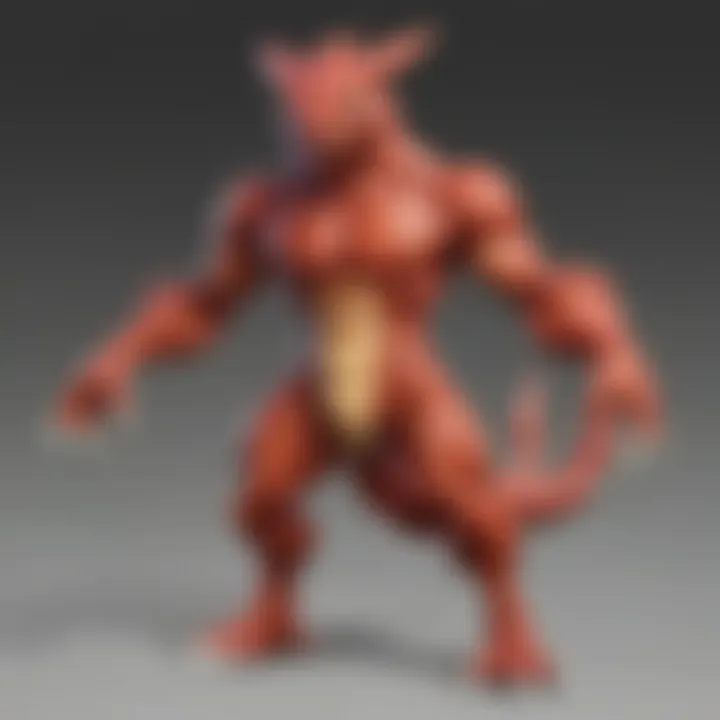Mastering Pokémon Abilities: A Complete Guide


Pokemon Game Overview
The Pokémon franchise started its journey back in 1996 with the release of Pokémon Red and Green in Japan. Over the years, it has transformed into a cultural phenomenon, attracting millions of fans across the globe. This evolution isn’t just about cute creatures and badges. The core mechanics of gameplay have significantly shifted, reflecting both advancements in technology and shifts in player expectations.
History of Pokemon games
From the first generation of Pokémon, where players could capture and train 151 creatures, to the latest releases that boast hundreds more, the history of Pokémon games is rich and layered. In the beginning, players traversed Kanto, catching Pokémon to challenge Gym Leaders. Today, players find themselves in regions with elaborate narratives, intricate gameplay mechanics, and a plethora of dynamic features.
Evolution of gameplay mechanics
As new generations emerged, Pokémon games saw some serious gameplay enhancements. The introduction of abilities in the third generation brought a new layer of strategy, fundamentally changing how battles unfolded. Abilities are unique traits that provide advantages in battle, from enhancing stats to providing immunity to certain conditions.
In addition, multiplayer capabilities and online battles have expanded the ways players interact with one another, allowing for a rich social component. This all adds to the excitement, making skills and strategies more essential than ever.
Intro to different game versions
Within the vast universe of Pokémon, various game versions have sprouted: handheld consoles, mobile applications, and even competitive video games. Titles like Pokémon GO have redefined how players engage with Pokémon in the real world, while mainline series games continually innovate gameplay mechanics, including abilities. These versions often cater to different styles of play, ensuring that whether you’re a casual player or a competitive battler, there’s something for you.
Tips and Strategies
To navigate the complex world of Pokémon, knowing a few tips can be a game changer. A savvy trainer understands how to utilize abilities effectively and how they cater to one's individual play style.
Beginner's guide to Pokemon games
For those just starting, focusing on a balanced team is vital. Make sure your Pokémon cover a range of types and abilities. This not only aids in battling but will give you a sense of adaptability against various opponents.
Advanced gameplay tactics
For seasoned players looking to sharpen their edge, mastering abilities is crucial. Knowing your Pokémon’s strengths allows you to predict and counter opponents' moves effectively. For example, Pokémon with abilities like Intimidate can lower an opponent’s Attack, giving you the upper hand right off the bat.
Team building strategies
Building a team involves understanding synergies. A well-rounded squad should include Pokémon that complement each other's abilities. Take time to explore different combinations and see what works best for your style.
Character Spotlights
Highlighting specific Pokémon can offer enlightening insights into their contributions to gameplay and strategy.
Featured Pokemon profiles
Some Pokémon shine brighter than others when it comes to abilities. Take Gardevoir, for instance, with the ability Trace, which allows it to copy an opponent's ability. This can turn the tide of battle in a split second!
Analysis of popular characters
When discussing popular choices, Pikachu remains iconic, not just for its cuteness but for its competitive viability thanks to abilities like Lightning Rod, attracting attacks and boosting special attack. These characters often provide more than just nostalgia; they are central to competitive strategies.
Impact of characters on gameplay
Understanding the strengths and weaknesses of various characters helps players craft more nuanced strategies. When you know which abilities can counter others, you dramatically enhance your chance of success.
Latest News and Updates
Keeping current with Pokémon news can significantly affect your gameplay and strategy decisions.
Recent game releases
Recent game releases introduce new regions, Pokémon, and often new abilities. Keeping an eye out for these changes can help you adapt swiftly to evolving gameplay.
Patch updates and events
Patch updates often tweak Pokémon abilities, so paying attention to these can give you an edge in battles. Events provide chances to obtain rare abilities, making it essential to stay informed.
Rumors and speculations
The Pokémon community is buzzing with rumors about upcoming games and abilities. Community discussions on platforms like Reddit often spark interesting theories and predictions regarding future game mechanics.
"Understanding abilities isn’t just about knowing what they do; it’s about predicting how they change the entire landscape of the game."
Arming yourself with knowledge about abilities is one way to truly elevate your experience and enjoy the game to its fullest. With the right information, both newcomers and veterans alike can look forward to the myriad possibilities that await in the expansive Pokémon universe.
Prelude to Pokémon Abilities
Understanding Pokémon abilities is a cornerstone of gameplay for any Pokémon trainer. Abilities not only shape how battles unfold but also influence strategic planning outside of combat. For instance, in a double battle, choosing Pokémon with synergistic abilities can turn the tide in the blink of an eye. This elegantly highlights the necessity for trainers to familiarize themselves with these mechanics for maximizing their effectiveness.
The purpose of this section is to break down what abilities are and their significance in the broader context of Pokémon mechanics. Abilities can determine the effectiveness of moves, provide advantages in various conditions, and can sometimes even shift the entire dynamic of a battle. Here, we will explore their definition, function, and the evolution of these essential gameplay elements.
Definition and Purpose
At its core, a Pokémon ability is a special characteristic that each Pokémon can possess, often providing it with a unique benefit or altering the way it interacts within the game. For example, take Levitate, an ability that protects a Pokémon from Ground-type moves, granting a significant advantage. This ability fundamentally changes how a trainer might approach battles when pitted against particularly formidable opponents. Each Pokémon can have one of multiple abilities, with some being exclusive, making the selection process pivotal.
The purpose is multifaceted:


- Diversification of Strategy: Abilities create a variety of strategies, encouraging trainers to mix and match different Pokémon to craft a well-rounded team.
- Tactical Depth: Exploiting abilities can lead to ingenious moves on the battlefield, where anticipating opponent’s strategies can provide a much-needed edge.
- Engagement in Gameplay: Knowing the intricate abilities can lead to a more engaging experience, enhancing enjoyment and satisfaction as trainers become more adept.
Evolution of Abilities
The landscape of abilities has seen significant changes since their inception in the Pokémon universe. When abilities were first introduced in the third generation of games, they were relatively simple. A Pokémon could have only one ability, and the abilities themselves were often basic in terms of their effects. However, as the series progressed, more complex mechanics emerged.
Consider how abilities now operate with intricate interactions. For instance, Prankster allows Pokémon to use status moves with priority, fundamentally altering turn order in a way that can confuse opponents. This evolution reflects a move toward an increasingly strategic game.
Moreover, the introduction of hidden abilities added another layer to the complexity. These abilities are not always accessible from the get-go and often require specific conditions or methods to obtain them. As a result, trainers are tasked with continual learning and adaptation, adapting to evolving game mechanics and strategies.
Ultimately, understanding the evolution of abilities allows trainers not just to appreciate the past but also to anticipate future changes. With new Pokémon generations continually adding to the mix, the ability landscape is one that requires an agile mindset, ensuring that trainers remain ahead in the game.
"To grasp the full potential of Pokémon battles, one must appreciate the nuances in abilities and evolve alongside the game."
Types of Abilities
Understanding the types of abilities in Pokémon is crucial for any trainer aiming to gain the upper hand in battles. Not all abilities are created equal, and their roles can drastically affect strategies and outcomes in competitions. Delving into types of abilities adds depth to gameplay, as recognizing the nuances between different abilities can substantially enhance your tactical approach. This section categorizes abilities into three main types: Standard Abilities, Hidden Abilities, and Mega Evolution Abilities. Each type has a distinct impact on how Pokémon perform in various scenarios.
Standard Abilities
Standard abilities are the bread and butter of Pokémon mechanics. Each Pokémon typically has one or two standard abilities that define its playstyle and role in battles. These abilities can range from enhancing stats to providing unique effects that can turn the tide in a confrontation. For example, Pokémon like Gardevoir possess the Trace ability, allowing it to copy an opponent's ability. This can be a game-changer when facing foes with advantageous abilities.
Some more notable examples include:
- Overgrow: Powers up Grass-type moves when the Pokémon’s HP falls below a third, ideal for turning desperate situations into a hopeful comeback.
- Intimidate: Lowers the opponent's Attack stat upon entering the field, making it a preferred choice for tanky Pokémon.
The presence of standard abilities provides each trainer a foundation to craft their strategies, making it imperative to familiarize oneself with these mechanics.
Hidden Abilities
Hidden abilities represent a niche aspect that often catches trainers off guard. Not every Pokémon can unleash their hidden prowess, as obtaining them typically requires specific conditions, like trading or events. However, once unlocked, they can introduce unexpected advantages that can flip the script in competitive play.
For instance, consider a Pokémon like Zygarde with the hidden ability Power Construct. This ability allows Zygarde to transform into its Complete Forme when below half health. This transition elevates its stats and turns it into a formidable opponent, showcasing how hidden abilities can redefine battles.
Some vital hidden abilities worth noting include:
- Adaptability: Enhances STAB (Same Type Attack Bonus) damage from 1.5x to 2x, a significant leap that no trainer would want to underestimate.
- Serene Grace: Doubles the chances of secondary effects occurring, making moves like Air Slash or Flinch even more dangerous.
Hidden abilities add a layer of strategy that requires trainers to think several steps ahead, considering their opponent's potential capabilities.
Mega Evolution Abilities
Mega Evolution abilities take the concept of abilities to a whole new dimension. When a Pokémon Mega Evolves, it not only transforms physically but also enhances its ability, giving it a distinct edge in battle. This mechanic is often game-changing, making the right Mega Evolution pivotal in strategic gameplay.
For example, Charizard can Mega Evolve into Mega Charizard X or Mega Charizard Y, each providing unique abilities—Drought and Tough Claws respectively. While Drought summons sunshine that boosts Fire-type moves, Tough Claws increases the damage of contact moves; each evolution poses different threats.
The notable features of Mega Evolution abilities include:
- Ability Enhancement: Turn the tables by enhancing existing abilities to create unanticipated advantages.
- Typological Change: Mega Evolution can also alter the Pokémon’s type which might help in countering opponents' weaknesses.
"The power of a Mega Evolution ability not only strengthens a Pokémon's arsenal but also reshapes the battlefield itself."
This deep dive into the types of abilities emphasizes how they function as fundamental building blocks within the realm of Pokémon. Whether through standard, hidden, or mega forms, each ability has a story to tell and a role to play in the dynamic world of Pokémon battles.
The Mechanics Behind Abilities
Understanding the mechanics behind abilities in Pokémon is vital for players who want to refine their strategies and enhance their overall gameplay. Abilities act as the unsung heroes of battle, bringing about advantages or unique effects that can turn the tide in tight situations. By comprehensively analyzing how abilities operate, trainers can make informed decisions that lead to victory. Players should grasp elements such as when and how abilities activate, their synergy with moves, and their situational advantages. Sprinkling a bit of knowledge on these mechanics can do wonders for a player's competitive edge.
Activation Conditions
Abilities don’t just spring into action willy-nilly; they have specific activation conditions that must be met. These conditions can range from something as straightforward as the health of the Pokémon to more unique environmental factors that can affect the battleground.
Some abilities, such as Intimidate, activate as soon as the Pokémon enters the battle, lowering the opponent's Attack. Other abilities, like Speed Boost, trigger at the end of the turn, providing an incremental edge.
Here’s a closer look at some common activation conditions:
- Health-Dependent Activation: Abilities like Sturdy come into play only if the Pokémon is at full health, allowing it to survive an otherwise devastating hit.
- Weather-Related Activation: Certain abilities like Drizzle only trigger under specific weather conditions, which may take a while to set up.
- Turn-Based Activation: Some abilities rely on the number of turns passed in battle, impacting the flow of combat as things evolve.
"Understanding when and why a Pokémon's ability activates can be the key to sealing the deal in battles."
Interactions with Moves
The intricacies of how abilities interact with moves can create complex situations in battles. Abilities can amplify or negate certain moves, leading to astonishing results. For instance, consider Contrary, which reverses stat changes instead of applying them normally. When a move like Leaf Storm is used, what would typically lower a Pokémon’s Special Attack raises it instead, providing an unexpected boon to its offense.
Here's some insight into common move interactions:
- Blocking Moves: Some abilities prevent certain moves altogether. Magic Bounce, for example, reflects status moves back at opponents, adding a layer of strategy around move selection.
- Power Boosts: Abilities like Adaptability enhance the power of STAB (Same Type Attack Bonus) moves, making virtually any standard attack from that Pokémon even deadlier.
- Type Advantage Modification: Consider Analytic, which boosts the power of the Pokémon's moves if it moves last during the turn; it can create advantageous scenarios, especially against faster opponents.
These interactions demonstrate that Pokémon abilities and moves intertwine, creating tactical depth that keen players can exploit to their benefit. Players must experiment with combinations, understanding that sometimes the most unusual pairings yield the most impressive results.
Categorizing Abilities
When diving into Pokémon abilities, it’s crucial to categorize them effectively. This categorization aids trainers by enhancing their strategic decisions during battles. Understanding the different types of abilities can dramatically change how a Pokémon contributes to their team. Let’s break it down into three primary categories: Offensive, Defensive, and Support abilities.


Offensive Abilities
Offensive abilities are designed to give Pokémon an edge in attacking their opponents. These powers can amplify damage, change how attacks function, or affect the opponent directly. A classic example is the ability Adaptability, which boosts the effectiveness of STAB (Same Type Attack Bonus) moves from 1.5x to 2x, making attacks significantly more potent.
Moreover, abilities like Technician can enhance weaker moves that might not usually see the light of day in competitive settings. It boosts moves with a base power of 60 or less by 50%. When harnessed correctly, these abilities can surprise opponents who might not expect a low-powered move to pack a serious punch.
The selection of offensive abilities must consider not only a Pokémon's type but also its role in battle. For instance, hyper-aggressive Pokémon can benefit from abilities that enhance their speed or critical hit rates, ensuring they strike first or deal substantial damage, while moderate attackers might prefer versatility to adapt to different opponents.
Defensive Abilities
Defensive abilities focus on resilience, giving Pokémon tools to withstand hits or evade attacks. An ability like Sturdy ensures that a Pokémon can survive a hit from a full-health enemy, essentially allowing it to absorb an incoming blow. This is particularly valuable in a world where every point of health can make a difference.
Another noteworthy defensive ability is Intimidate, which decreases the Attack stat of an opponent when the Pokémon enters the battle. This ability can be a game-changer, letting trainers use strategic switches to induce a drop in damage before their opponent can even land a hit.
Defensive abilities also often affect how the team as a whole operates. Pokémon with abilities like Reflect Type can turn their defensive strengths against opponents, reflecting not only damage taken but also their attributes. This adaptability means trainers must have a keen vision to evaluate and leverage these defensive capabilities effectively.
Support Abilities
Support abilities are the unsung heroes of any Pokémon team, focusing on aiding teammates or crowd-controlling opponents. A prime example is Tailwind, which doubles the Speed of Pokémon for five turns, giving a swift advantage that can turn the tide of battle.
There’s also Healing Wish, which allows one Pokémon to faint to fully restore the health of an active teammate. Although it sacrifices the Pokémon's own life, the strategy it opens can create opportunities for comeback scenarios.
These abilities often require precise timing and tactical foresight. A trainer's ability to read the opposing team's strategy can allow for the right moment to deploy support capabilities. It's about creating synergy and maximizing each Pokémon’s potential on the battlefield.
Remember, the key to mastering competitive play lies in not only knowing your Pokémon’s abilities but also how to categorize and synergize them within your team!
In closing, categorizing abilities not only streamlines your understanding but also enhances your strategic options during gameplay. By appreciating the nuances of offensive, defensive, and support abilities, players can truly elevate their Pokémon experience to stellar levels.
Strategic Implications of Abilities
Understanding the strategic implications of abilities in Pokémon isn’t just a shiny detail for the gameplay; it’s the heart and soul of a well-balanced team. Abilities have far-reaching effects that ripple through the dynamics of battles, shaping not only how individual Pokémon perform but also how they synergize with their teammates. The right ability can swing the tide of a match, giving an edge against adversaries and hindering their strategies.
Team Composition
When assembling a team, abilities should play a starring role in your decision-making process. Choosing Pokémon with abilities that complement each other can greatly enhance your overall effectiveness. For instance, consider how a Pokémon with the ability Drought—like Ninetales—can create sunny weather that boosts Fire-type moves while weakening Water-type moves. Pairing this with a Pokémon that excels in sunny weather, like Solar Power Shiftry, could yield formidable results.
- Synergy Examples:
- Drought (Ninetales) + Solar Power (Shiftry): Increases Fire-type move power and enhances Shiftry’s Speed and Special Attack in sunny weather.
- Intimidate (Gyarados) + Physical Attackers (e.g., Excadrill): Lowers the opponent's Attack stat while Gyarados can switch into the fray to face stronger foes, making physical attackers like Excadrill hit even harder.
On the flip side, it’s crucial to avoid pairing Pokémon whose abilities may interfere with one another. Imagine having a Drizzle Pokémon like Politoed next to a Solar Power Pokémon. Every time Politoed creates rain, it diminishes the effectiveness of that sunlight-dependent Pokémon.
Having a mix of abilities in a team not only provides versatility but also adds layers to strategy, allowing for adaptability in the face of unpredictable opponents. Whenever players are choosing Pokémon, a keen understanding of how to align and balance abilities is essential.
Counter Strategies
In competitive play, being aware of opposing Pokémon abilities can be the difference between victory and defeat. Developing counter strategies requires players to anticipate the moves of their opponents based on the abilities in play. An example of this involves recognizing when to play aggressively or defensively, depending on the abilities shown.
Some effective counter strategies include:
- Use of Priority Moves: If you’re up against a Pokémon with Speed Boost that threatens to outspeed you, opting for a priority move (like Sucker Punch) may deal significant damage before the opponent can take the upper hand.
- Status Infliction: Abilities such as Guts can amplify a Pokémon’s Attack when suffering from a status condition. Thus, utilizing moves like Will-O-Wisp can neutralize this advantage, leaving your opponent’s strategy in tatters.
- Predictive Switches: Masterful prediction of switches can put you ahead of adversaries. If you know your opponent relies heavily on Levitate, you might choose to use moves like Earthquake when they least expect it, catching them off guard and disrupting their game plan.
"Understanding the versatility of abilities can help players not just in building their team, but in playing cleverly against an opponent’s strengths."
In summary, abilities are like pieces on a chessboard. Each one impacts the game uniquely, and understanding their implications when crafting team formations or counter strategies brings players one step closer to mastering the battlefield in the Pokémon universe.
Ability Synergy
Understanding the concept of Ability Synergy is crucial for any Pokémon trainer looking to enhance their competitive edge. Synergy in this context refers to the way different abilities can work together to create advantageous strategies in battles. When players harness the potential of abilities that can complement each other, they often find themselves with a distinct advantage over their opponents.
One significant aspect of this synergy is the ability to create potent combinations that can turn the tide of battle. Trainers should look for partners whose abilities overlap or augment one another, allowing for greater versatility in both offense and defense. This can lead to a strategic setup where one Pokémon supports another, thus creating a chain reaction that maximizes damage output or minimizes incoming threats.
Complementary Abilities
Complementary abilities are those that enhance a partner's strengths. For example, a Pokémon with the ability Lightning Rod draws in all Electric-type moves. Pairing it with a heavy-hitting Electric-type like Zekrom allows for a setup where the Lightning Rod user absorbs potentially damaging moves while simultaneously setting up for a devastating strike. This combination not only protects your Pokémon but also directs the opponent’s attack into a trap of sorts.
When considering complementary abilities, trainers could also explore scenarios involving abilities like Drizzle, which summons rain, working effectively with Swift Swim. Here, a Pokémon benefiting from both abilities will have increased Speed and benefit from Water-type moves, exploiting the weather condition entirely.
Contradictory Abilities
Contradictory abilities, on the other hand, can undermine a team's performance. For instance, abilities like Intimidate (which lowers the Attack of opposing Pokémon upon entering the battle) might hinder a Pokémon who relies on its physical Assault capabilities. Units like a Bishop with Defiant also come into play, as they will relish the opportunity to boost their Attack when facing an Intimidate Pokémon.
It’s vital for trainers to weigh the potential drawbacks of contradictory abilities as they can disrupt the flow of battle. These abilities can stifle a team’s overall effectiveness if not managed carefully. By being mindful of the abilities that confer strength to your team versus those that introduce inconsistencies, players can make more informed decisions as they construct their squads.
As Pokémon battles are as much about strategy as they are about raw power, understanding the synergy between abilities is the key to elevating your performance.
In summation, recognizing and utilizing both complementary and contradictory abilities can significantly influence battle outcomes. The ability to combine strengths while being aware of potential pitfalls could very well be the difference between a victorious takeaway or a challenging defeat. Trainers should consistently evaluate their Pokémon's abilities in conjunction with their team's composition to maximize strategic effectiveness.
Notable Abilities by Pokémon Species
In the vibrant and colorful world of Pokémon, each species boasts unique abilities that can greatly affect gameplay and battle outcomes. Abilities define a Pokémon's inherent skills, which can make or break a strategy. Focusing on notable abilities tied to specific Pokémon species gives trainers the insight needed to navigate competitive waters effectively.


Legendary Pokémon Abilities
Legendary Pokémon are the mythical titans in the Pokémon universe, often revered for their overwhelming strength and unique abilities. Each legendary Pokémon comes packed with abilities that not only reflect their lore but also significantly influence game dynamics.
Take Mewtwo, for instance. Its ability, Pressure, causes opponents to use more PP for their moves, subtly wearing them down over time. This can lead to extended battles where resource management becomes key. On the flipping side, Zygarde has Power Construct, which enables it to revert to a stronger form when its health drops, thereby turning the tide in critical moments. Trainers must understand these abilities not just in terms of stats but also how they can manipulate the flow of the game.
When evaluating legendary Pokémon
- They often have higher base stats.
- Their abilities can complement strategy by altering battle norms.
- Understanding their abilities can lead to effective counters while facing them in matches.
"The right ability can turn an ordinary Pokémon into a formidable force; knowing when and how to leverage these abilities is essential for any serious trainer."
Regional Variants and Their Abilities
The introduction of regional variants has added a fascinating twist to abilities and strategies in battles. Instead of a one-size-fits-all approach, these variants bring distinct abilities that highlight their regional adaptations and environments.
Take Alolan Vulpix, for example. It has the ability Snow Cloak, which raises its evasiveness in hail conditions. This opens doors to unique strategies that employ weather conditions, showing how abilities can synergize with team setups. Another standout is Galarian Weezing, which boasts Neutralizing Gas. Here, it neutralizes all abilities of Pokémon on the field, essentially reshaping the battlefield to the user’s advantage.
The dynamics of regional variants offer several considerations:
- They emphasize the importance of adaptability in battle tactics.
- They encourage trainers to explore diverse team compositions to maximize effectiveness.
- Understanding a regional variant's niche abilities can grant insight into emerging strategies that could surprise opponents.
Embracing these region-specific abilities helps trainers mold their strategies in a constantly evolving competitive landscape. Whether it’s exploiting weather effects or countering enemy abilities, the depth of gameplay expands significantly with this uniqueness.
Impacts of Abilities on Competitive Play
The realm of competitive Pokémon battles is not just about type advantages or damage calculations; abilities infuse a different flavor into these contests, functioning as the backbone of strategy. They are the unsung heroes, subtly driving decisions that can often turn the tide of battle. Such importance cannot be overstated; the right abilities can turn a lackluster team into a formidable opponent. They shape the way trainers craft their teams, approach opponents, and refine their battle tactics.
The Game-Changing Nature of Abilities
In competitive play, the nuances of abilities can drastically change the effectiveness of various Pokémon. Consider a Pokémon like Garchomp which, with its ability Rough Skin, deals damage to opponents on contact. This not only makes Garchomp a threat but also encourages players to think twice about using certain physical attackers against it. This is just one example, and many trainers recognize that understanding the layered implications of each ability can lead to better performance in tournaments.
Ability Usage in Tournaments
When it comes to tournament play, the selection and utilization of abilities can mean the difference between glory and defeat. Strong players often build their strategies around abilities that complement their Pokémon’s strengths and cover for their weaknesses.
- Selecting Hidden Abilities: Trainers often scout out those rare Pokémon with hidden abilities, such as Hawlucha’s Unburden, which doubles its speed upon consuming an item. This can catch opponents off guard, especially during high-stakes matches where surprise factor matters.
- Tailoring Team Synergy: For a team comprised of offensive threats, it might make sense to lean on abilities that enhance overall aggression, like Sheer Force, as seen in Nidoking. Alternatively, defensive setups might rely on abilities like Regenerator on Tangrowth to enhance survivability.
The best trainers often exploit the full potential of each Pokémon’s ability, using them creatively to disrupt opponents’ strategies. They also watch for popular ability choices in the competitive arena, allowing them to adopt countermeasures or their own strategies tailored to the metagame.
"Abilities are not just mechanics; they are the art of strategy wrapped in each Pokémon’s essence."
Meta Shifts Due to New Abilities
The competitive Pokémon landscape is ever-evolving, and often, new abilities can spark significant shifts in current meta. When new Pokémon are introduced with ground-breaking abilities, teams are restructured, strategies are redefined, and sometimes entire playstyles shift.
- Examples of Notable Shifts: The introduction of Dragapult with its ability Clear Body led to a rise in popularity of certain Togekiss strategies, as the latter's Serene Grace ability was often seen as less effective against foes immune to status. On the flip side, the release of Urshifu, with abilities like Unseen Fist, shifted the landscape by allowing it to bypass certain defensive tactics that had long been staples in competitive play.
- Adapting to Change: Trainers are placed on the back-foot and made to re-evaluate their teams and strategies. Some Pokémon, once reliable, may dwindle in favor as newcomers redefine what is effective. Gen changes foster a continuously evolving environment, and keeping an eye on new abilities is crucial for long-term success.
To sum it up, abilities do not merely supplement gameplay; they are pivotal to the high-stakes world of competitive Pokémon. Understanding their impacts can open doors to new strategies and elevate a trainer’s performance in tournaments, solidifying the significance of keeping abreast of emergent abilities and shifts in competitive dynamics.
Future Considerations in Pokémon Abilities
Exploring the future considerations related to Pokémon abilities opens a panorama of potential strategies and enhancements that could greatly reshape gameplay. As Pokémon continues to evolve with new generations, the mechanics and strategies surrounding abilities remain in a constant state of flux. These changes can influence how players strategize in both casual and competitive environments. Exploring the future of abilities not only heightens awareness of possible alterations but also prepares trainers for the implications those changes can have on their teams.
Speculations on New Abilities
As we look to the horizon, speculations about new abilities can become a hot topic among the Pokémon community. With each new region introduced and fresh generation launched, the addition of unique abilities could serve to diversify gameplay. For example, think about how the introduction of dynamic weather effects altered strategies. In this regard, new ability concepts could be aimed at introducing specific advantages that balance existing mechanics or even counteract overpowered strategies from previous generations.
Envision an ability that shifts a Pokémon's typing under special conditions or one that enhances certain stats based on battling experience. The potential for an ability that might change based on environmental conditions, much like terrain-based abilities, could add layers of strategy. Players who remain proactive in seeing these possibilities will be better equipped to adapt their strategies, making foresight crucial. It’s essential to dialogue within communities, such as on platforms like reddit.com, where speculation on competitive implications often thrives.
Revisions of Existing Abilities
Revisiting and revising existing abilities is just as vital as considering new ones. The Pokémon Company has a history of adjusting abilities to ensure game balance. This often addresses complaints from players regarding certain abilities that may dominate gameplay. For instance, abilities that were incredibly powerful upon release may later be adjusted to level the competitive playing field, as seen with abilities like Intimidate, which were rebalanced over time to reduce their overwhelming presence.
Common considerations when revising abilities include:
- Balanced Gameplay: Ensuring no single ability overshadows others is key to maintaining engagement.
- Player Feedback: Taking into account community feedback can influence which abilities will get an overhaul.
- Synergy with New Features: As expansions introduce new Pokémon and mechanics, existing abilities may require updates to align with these changes.
Continual assessment and revision of abilities is not just a matter of tweaking numbers; it also reflects the growing landscape of strategies that players develop. Keeping an ear to the ground within fan discussions can provide insight into which abilities may be ripe for revision. As competitive players strategize around current abilities, they can prepare for surprising changes, making adaptability crucial for success.
The evolving world of Pokémon abilities is a rich terrain for innovation and strategic exploration. Keeping up with potential revisions and speculative additions will not only enhance gameplay but also cultivate a deeper appreciation for the ever-changing tactics within the Pokémon universe.
Ending
Understanding Pokémon abilities is crucial for aspiring trainers and seasoned players alike. Each ability not only brings its own flavor to gameplay but also presents unique opportunities and challenges during battles. A firm grasp of how these abilities interplay can dramatically enhance a player's strategic approach, leading to more victories and greater enjoyment in the Pokémon world.
Summary of Key Insights
- Abilities as Game-Changers: Abilities can turn the tide of battle, altering the effectiveness of moves or providing critical advantages in various situations. For example, the Levitate ability grants immunity to Ground-type moves, keeping a Pokémon safer in certain matchups.
- Categorization and Strategies: Familiarity with different categories of abilities—offensive, defensive, and support—enables players to build more cohesive teams. It’s not just about picking Pokémon; it’s about understanding how their skills can complement one another and cover weaknesses.
- Competitive Play: In tournaments, knowledge of abilities can significantly impact choice. Players can counter popular strategies and adapt to shifting metas by considering how abilities have affected competitive play in the past.
"The right ability at the right time can be the difference between a sweeping victory and a crushing defeat."
The Role of Abilities in Pokémon Strategy
Abilities serve as foundational elements in Pokémon strategy, shaping not just how individual Pokémon perform but also dictating overall team composition. Choosing the right set of abilities can maximize a team’s offensive and defensive potential. For instance, a trainer that uses Dragonite with its Multiscale ability might prioritize setting up with moves like Dragon Dance, knowing it can take a hit without flinching.
Furthermore, players must remain agile in their strategies, adapting to the dynamic battlefield where every opponent may exploit certain abilities differently. The synergy created by combining Pokémon with distinct abilities can yield surprising outcomes in battles, where unexpected interactions can make all the difference. To truly master Pokémon battles, it isn't merely about picking the strongest creatures; one must delve into the nuances of abilities, evaluating not just their direct effects, but also how they interlace with the current strategies in play.







